Ankle Weights After Knee Replacement: Are They Good For Recovery?
Are you currently recovering from a knee replacement surgery?
Believe me, I know how tough the road to recovery can be, but I will tell you, it’s totally worth it in the end!
In the early stages of recovery, you might experience pain, swelling, and limited range of motion in your affected leg.
Even walking short distances is impossible without the help of a walker or crutches.
I can remember struggling with basic, simple exercises like ankle pumps, heel slides, and knee bends during my physical therapy sessions.
But the good news is it does get better – you get stronger!
As my range of motion improved and I progressed to walking without an assistive device, my therapist started strength training exercises.
We started with bodyweight exercises and then moved on to ankle weights to target and strengthen the muscle groups around the new joint.
Now, you might be wondering, are ankle weights helpful for your recovery?
The answer is yes, but it’s not a one-size-fits-all solution.
We all recover differently, and some people may struggle with adding any weight to their rehab program.
Let’s take a closer look at the benefits of using ankle weights and whether they are a good idea for your recovery.
I’ll even share some exercises my therapist recommended for me to do with ankle weights.
So, keep reading!
We’re getting closer and closer to getting back to our normal activities without taking any unnecessary risks.
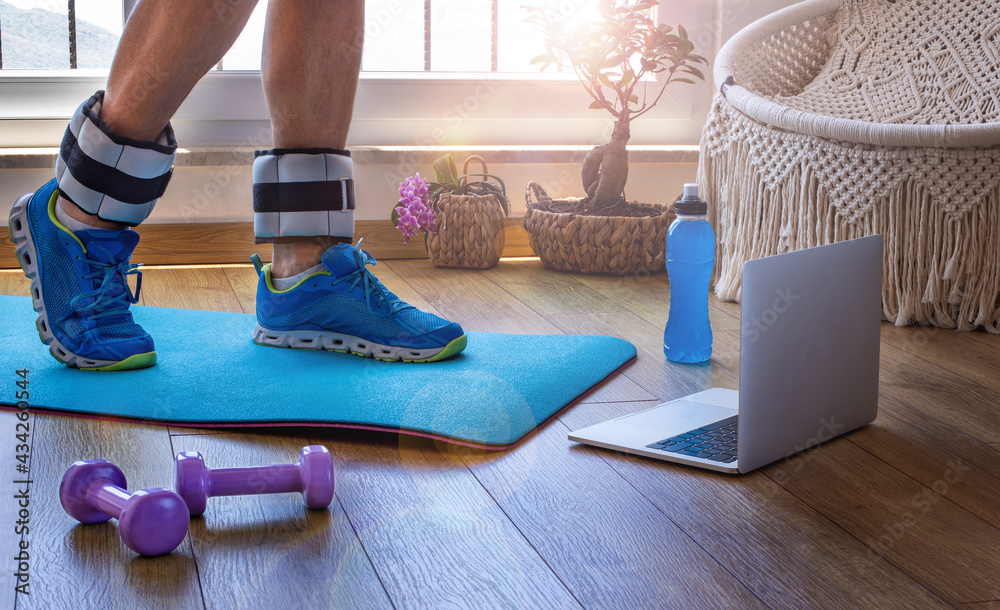
4 Pros to Using Ankle Weights After Knee Replacement
1. Improved Range of Motion and Balance
Ankle weights were great for improving my range of motion and balance.
they added a slight resistance to my joint and turned up the intensity, forcing all of my muscles to work together.
Not only did it help me move better, but it also helped with my strength gains.
2. Improved Muscle Strength Around the Knee Joint
When I started working out with ankle weights, I was able to strengthen my quad muscles (that’s the muscle at the front of your thigh) and other supporting muscles, like my hamstrings and calves.
The added weight required me to use more effort, giving my muscles a good strengthening session.
I was instructed to start slow and light to avoid discomfort or injury.
I used ankle weights around 1-2 pounds and did fewer reps.
My therapist slowly increased the weights and reps as I could tolerate more.
3. Increased Flexibility
Ankle weight also helped increase the flexibility in my affected knee.
While working out with ankle weights, the added resistance pushed my joints to stretch beyond their usual limits.
This was super helpful in relieving my tight muscles!
4. Decreased Stiffness and Swelling Post-Surgery
I noticed that the stiffness and swelling slowly decreased as my leg got stronger.
Which, of course, helped decrease my pain.
4 Cons of Ankle Weights After Knee Replacement
1. Risk Of Injury
When you place additional strain on a joint that has undergone repair, it can lead to inflammation and pain in the joint and surrounding ligaments.
Additionally, any instability caused by a weakening of the muscles due to overuse can increase the chances of incurring future knee injuries.
So, if you experience pain or discomfort while using the weights, stop immediately and talk to your doctor, physical therapist, or athletic trainer. They can help you modify or adjust your exercises so that they are safe and effective.
2. Ankle Weights May Be Uncomfortable While Exercising
Like any workout equipment, ankle weights come in all shapes and sizes. Choosing a pair of ankle weights that work for your body makeup is important.
Make sure that you purchase a light set of ankle weights (1-2 pounds) since this would be the best weight to start with after a knee replacement.
This way, you are sure to have fewer issues with the fit and comfort of the weights.
3. New Pain In Other Areas Due To Improper Form
When it comes to any exercise program, form is everything!
If you are not correctly using exercise equipment, including ankle weights, you could cause pain or injury to other areas of your body, such as your lower back, ankles, or hips.
Discuss ankle weight exercises with your healthcare team.
They can teach you how to do the exercises correctly and with proper form to avoid any injury or pain.
4. May Not Be Suitable For Everyone
While ankle weights may be good for most people after a knee replacement, they are not the best option for everyone.
It is important to remember that each person’s recovery journey is unique, and different factors may affect how quickly someone recovers from knee replacement surgery.
Can You Overdo Exercise After A Knee Replacement?
After a total knee replacement, it is possible to overdo exercise.
I totally get it – I couldn’t wait to jump back into my weightlifting routine.
It drove me bonkers, not being able to pick up where I left off before surgery.
But you have to be patient and cautious, just because you could do it before the knee replacement doesn’t automatically mean it’s a smart do it right afterward.
It’s important to listen to your body.
If you experience any pain or discomfort during exercise, don’t hesitate to reach out to your rehab team.
They might want to take a look at how you’re using the ankle weights to make sure that you’re using proper form.
If you are, they might suggest lowering the weights and reps or holding off on using weights altogether.
Don’t worry, it’s probably just going to be temporary. The main goal is to keep you and your new knee safe and avoid any setbacks.
Before you know it, you’ll be back to your resistance training again!
5 Low Impact Exercises to do with Ankle Weights After Knee Surgery
The following exercises are some of the ones that my therapist encouraged me to do with ankle weights after my total knee replacement surgery.
But since everyone recovers differently you should talk to your physical therapist or orthopedic surgeon before you begin doing resistance exercises with ankle weights.
1. Leg Marches
This was the first exercise that my therapist allowed me to do with ankle weights. When I first started the exercise, I was only allowed to do it with body weight.
She then slowly progressed me to light ankle weights around 2-3 weeks post op.
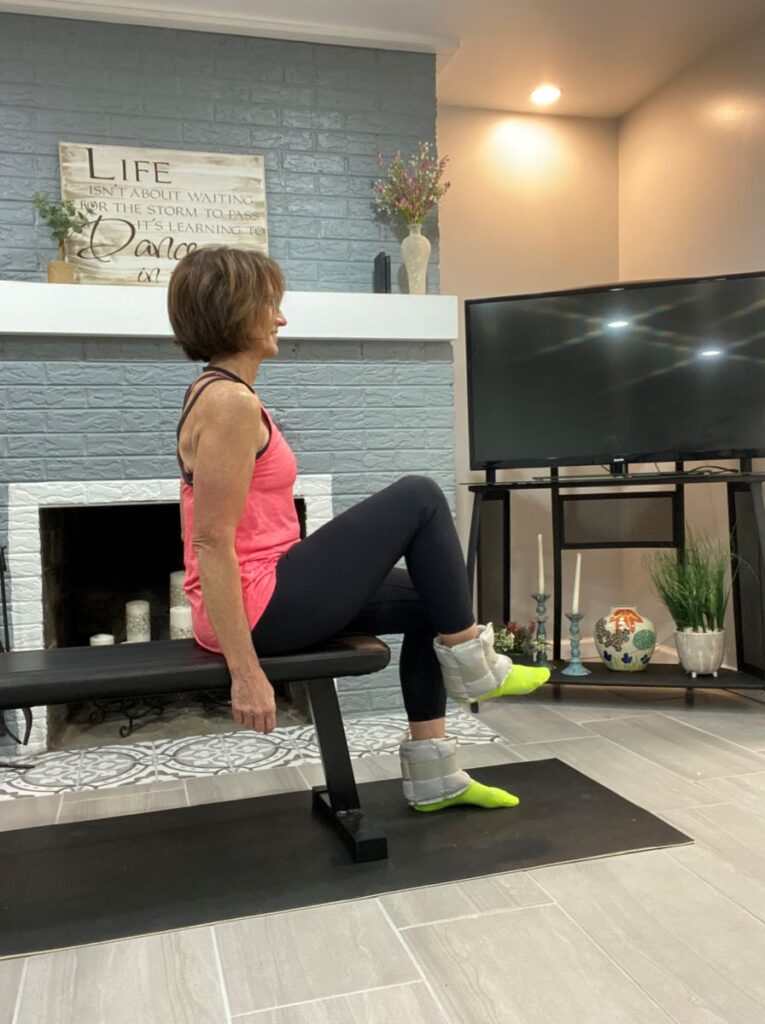
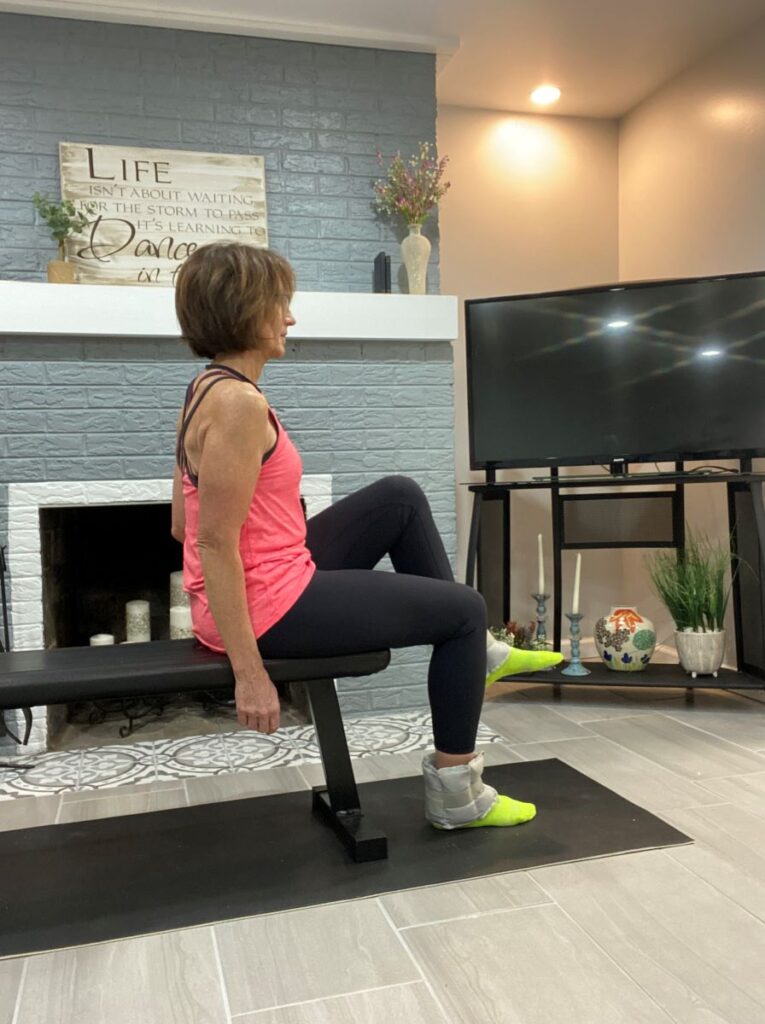
To perform this exercise:
- Sit on a chair or your weight bench.
- Place the ankle weights on your ankles.
- Bend knees to 90 degrees.
- Lift one leg up and then lower back to the ground
- Alternate legs so that you can work both legs.
- Do 5-10 lifts per leg for 2-3 sets. If this is to much at first, just do 3-5 per leg for 1-2 sets.
- Be sure to rest in between sets.
2. Prone Leg Extensions
I was encouraged to do this exercise before and after surgery because it was one of the best exercises to help regain the extension of my leg.
It’s very helpful to have as much knee extension as possible before surgery.
After surgery, my therapist had me begin this exercise with only body weight (which was harder than I thought it would be) and then progressed to light ankle weights approximately 1-2 weeks later.
To perform this exercise:
- Place light (1-2 pounds) ankle weights on your ankles.
- Lie on your stomach on your bed, the floor or a weight bench – I will say the bed was more comfortable when I started doing this exercise after surgery. But you do what works for you.
- Make sure that your knees are on the surface, only have your leg from mid-calf to foot hanging over the edge.
- Now just let your leg stretch by lying still.
- Start by only doing this exercise for a few seconds – trust me you will feel it! Then slowly increase the time as you can tolerate. Don’t push this one to hard at first.
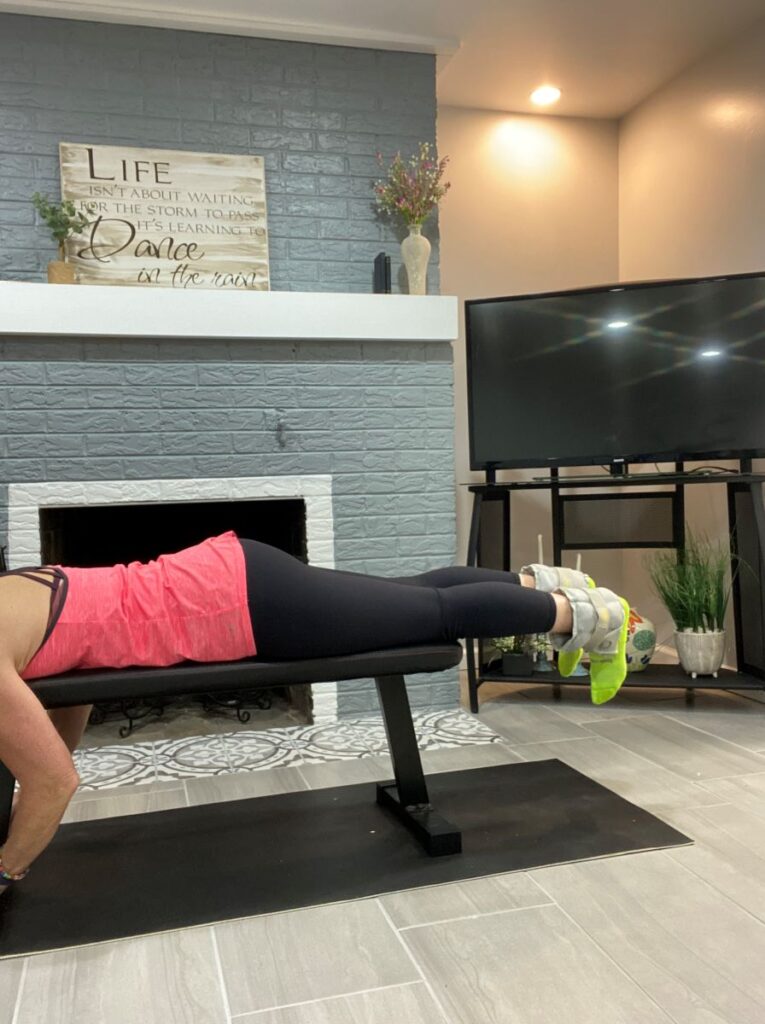
3. Calf Raises
Calf raises with ankle weights is a simple way to strengthen the calf muscles after a knee replacement.
To perform this exercise:
- Start in a standing position with ankle weights around your ankles.
- Feet shoulder-width apart and toes pointed forward.
- Stand close to a chair or a wall for support.
- Lift both heels up off the floor and hold for a few seconds before slowly lowering them back down. If this is to hard at first just do one foot at a time.
- Repeat this exercise 8-10 times for 2-3 sets, resting between each set. Again back off and do fewer reps or sets at first if this is difficult.

4. Straight Leg Raises
This one is a little more advanced and may take a few weeks before you will be able to do the exercise.
Again, my therapist started me out with only body weight.
When I was stronger and could do the exercise without discomfort then my therapist started to add light weights.
To perform this exercise:
- Starting position should be on your back with ankle weights around your ankle.
- Place feet flat on the floor or extend your legs out straight.
- Lift one leg off the ground keeping the leg straight.
- Hold for a few seconds before lowering it back down.
- Then rest for a few seconds and repeat with the opposite leg.
- Start slow with this one and build up the reps and sets as tolerated.
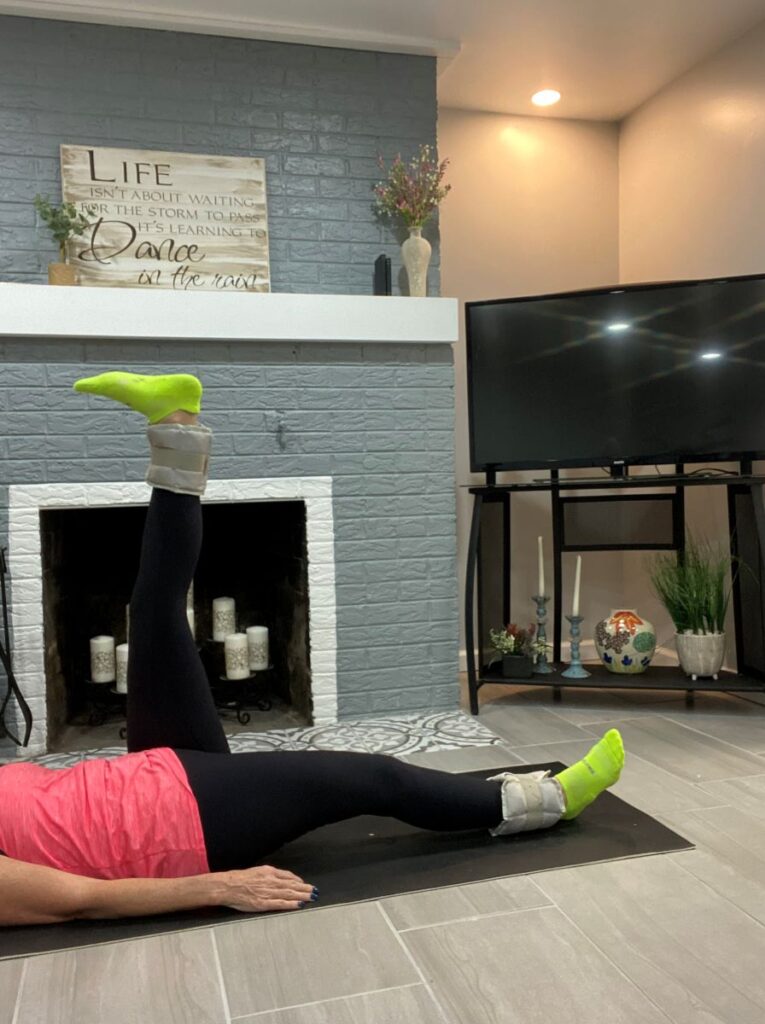
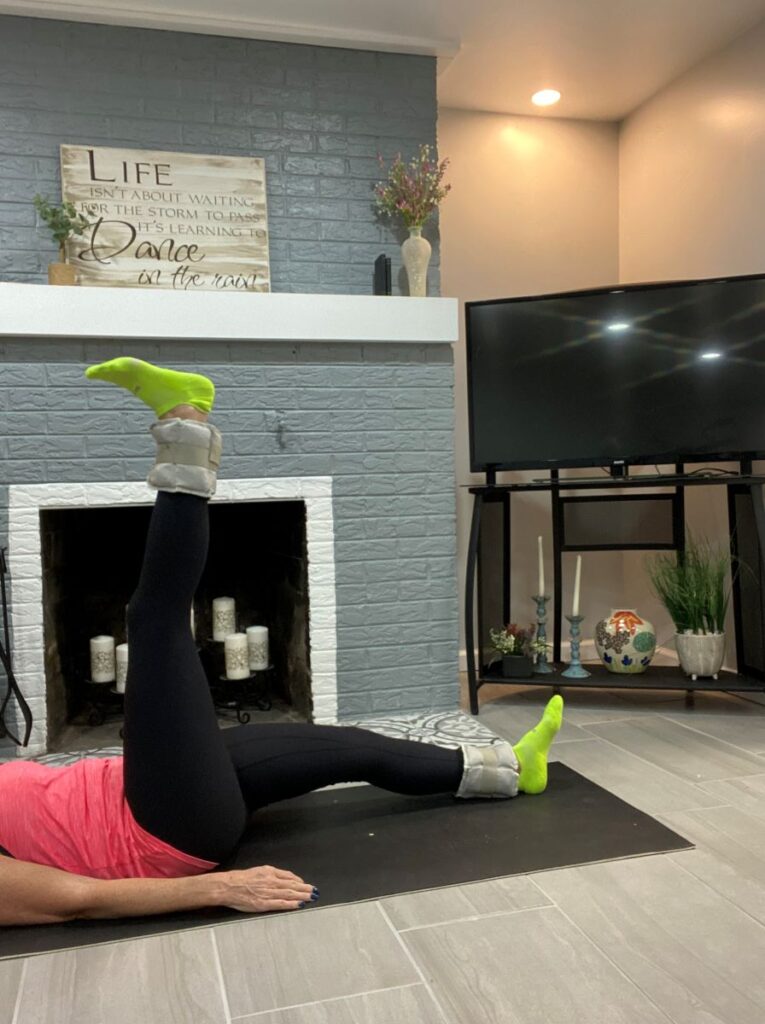
5. Step Ups
This was one of the last exercises that my therapist let me do with ankle weights.
It helped with stair climbing at home.
Again, I started with body weight only.
Ankle weights were a great way to increase the intensity of this exercise.
To perform ankle weight step ups:
- Stand on a low stool or your steps.
- You can either use the ankle weights in your hands for extra weight or around your ankles.
- Step up on the stool or the step with one foot, keeping the other foot on the ground.
- Drive up through your heel of your lead or moving foot to stand tall on top of the stool or step.
- Step back down so both feet are on the floor.
- Then repeat with the opposite foot.
- Alternating feet for 5-10 times per foot.
- Increase reps and sets as tolerated.
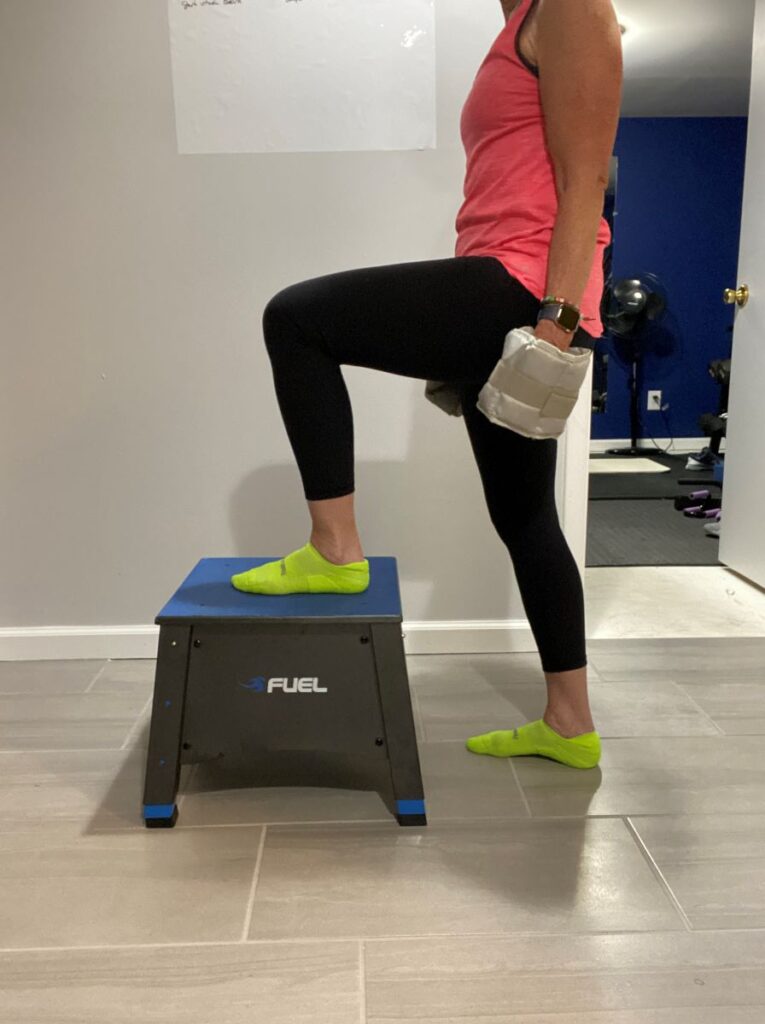

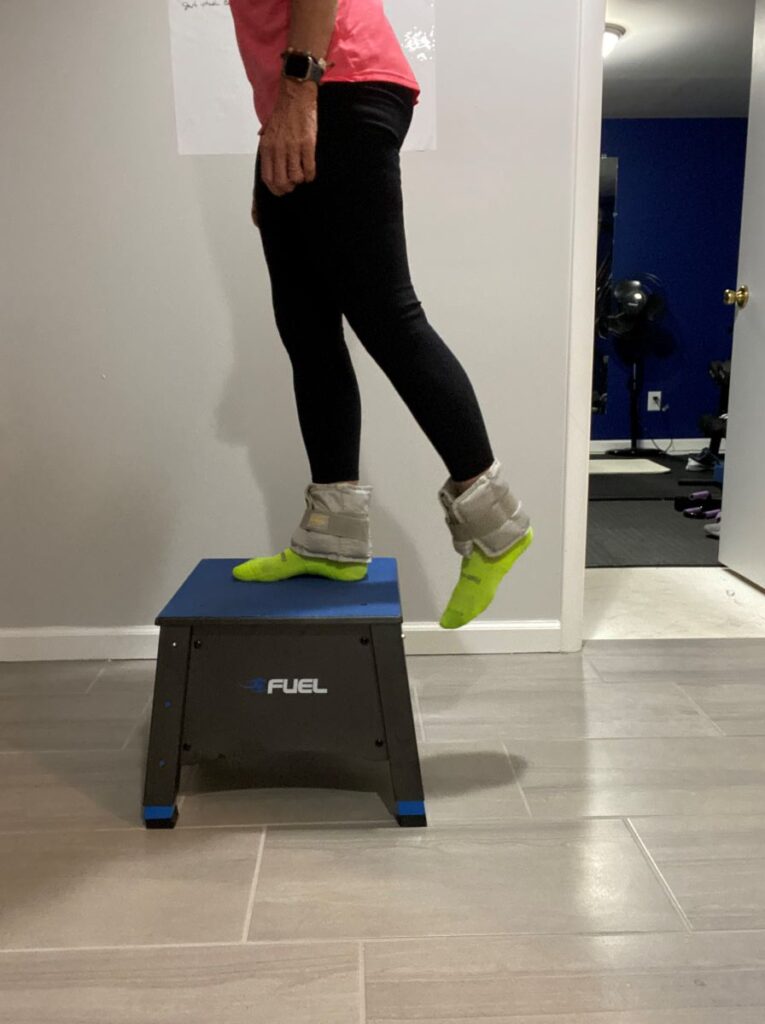
Conclusion
I understand that the thought of using ankle weights after a knee replacement surgery may seem overwhelming.
But these simple and lightweight tools can actually make a huge impact on your recovery process.
Not only do ankle weights help increase your strength and stability, but they also improve your range of motion and reduce pain.
And who doesn’t want that, right?
Of course, it’s important to talk to your orthopaedic surgeon or physical therapist before including them into your exercise program.
Your recovery journey should include a mix of physical therapy exercises, low-impact exercise like swimming or biking, and yes, the use of ankle weights.
Remember, everyone’s journey is different.
Trust your body, follow medical advice, and there’s no doubt that you will have a successful recovery.
So, keep pushing forward, keep striving for progress, and let ankle weights be your supportive companion as you regain mobility and reclaim an active lifestyle once again.
I hope this blog post has given you some valuable insights and plenty of food for thought.
Sending you all the best vibes for your healing process!
